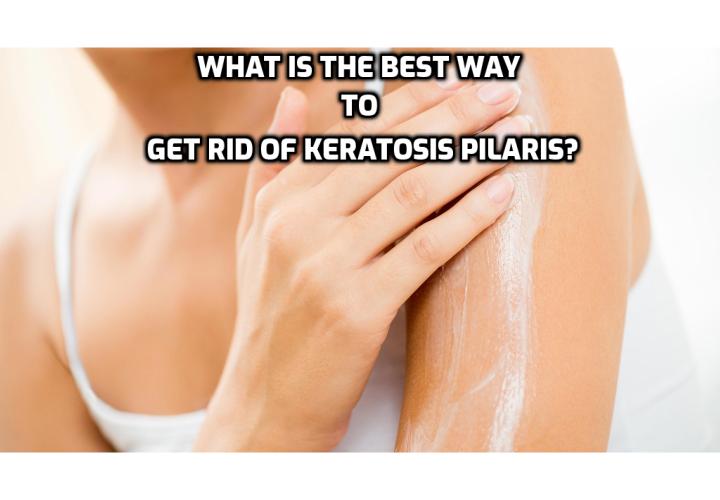Get
Rid of Keratosis Pilaris - Prognosis Of Keratosis Pilaris
Those
who suffer from keratosis pilaris experience patches of rough,
tiny bumps across the surface of their skin. Areas of the body affected by this
condition include the upper arms, the thighs, and sometimes the buttocks or the
face. Despite its unpleasant appearance and resistance to treatment, keratosis pilaris may fade slowly with age in some
patients.
In
general, keratosis pilaris manifests as a chronic skin
condition that worsens or improves in alternating periods. Anyone can be
affected by keratosis pilaris, as patients belong to all ages,
genders, and ethnic groups. The condition is most commonly seen in children 10
years old and under, and it usually worsens dramatically during adolescence for
both males and females.
Clinical
studies suggest that the overall prognosis for individuals with keratosis pilaris is highly positive. The
condition tends to improve over time, although it does persist in varying
periods of severity and reduction in some patients.
Usually,
keratosis pilaris does not involve significant complications
like scarring, although this and other side effects can result as a consequence
of intensive treatments or poor skincare.
Approximately
50% of all people with keratosis pilaris experience a worsening of their
symptoms during the winter. Among these patients with worsened symptoms during
winter, only 60% notice any substantial improvement during the summer. This is
generally attributed to the relative lack of humidity during cold, harsher
seasons.
Keratosis pilaris will improve dramatically in an estimated
35% of patients, usually by late adolescence. According to research by Dr.
Derek Chu and colleagues, the average age of improvement is 16 years. For some
patients, however, the symptoms of keratosis pilaris remain unchanged from the
time of diagnosis: approximately 43% of patients fall into this category. In a
minority of patients (up to 20%), symptoms may worsen over time.
As indicated by these statistics, people with
keratosis pilaris can experience varying outcomes regarding the severity and
persistence of their symptoms. If you have keratosis pilaris, it is important
that you see your doctor or a dermatologist to address any concerns. He or she
can suggest the most effective treatments and at-home remedies to control your
symptoms as much as possible.
Surgical
Care To Get Rid Of Keratosis Pilaris
Keratosis pilaris is a common skin condition
that involves raised, bumpy patches along body surfaces that are prone to fine
hair growth, such as the arms, legs, and buttocks. These patches are created by
plugs of keratinized skin cells, which block the opening of hair follicles,
causing skin to feel like permanent goose bumps. Although most cases of
keratosis pilaris disappear over time without extensive treatment, some
individuals seek more extensive forms of treatment to reduce their symptoms.
These procedures include options such as
chemical peels, dermabrasion and microdermabrasion, photodynamic therapy, and
laser therapy.
Preparing skin with a chemical peel removes dead skin cells,
making moisturizing more effective and smoothing out rough or uneven skin.
Similarly, dermabrasion and microdermabrasion gently
exfoliate skin with vacuum-assisted suction to reveal younger, fresher skin
below and to reduce the appearance of unsightly bumps.
In dermabrasion, this is accomplished by using a wire brush
or a diamond wheel with rough edges to level the top layers of the skin, which
stimulates the growth of new skin to replace the damaged skin removed during
the procedure.
In microdermabrasion, however, a dermatologist or plastic
surgeon sprays tiny exfoliating crystals onto the skin to reduce dullness,
discoloration, and age spots.
Laser hair-removal, in contrast, is used to
diminish hair growth in the affected areas, which often reduces the number and
severity of bumps on the skin's surface.
Photodynamic therapy or blue-light therapy is also sometimes
suggested as a means of destroying certain affected skin tissues to enable new
skin growth. No studies have shown a cure of keratosis pilaris with any laser
therapy, however.
Surgical options for keratosis pilaris are only
necessary for cosmetic reasons, and therefore are often not covered by
insurance companies. As a result, they can often involve long-term expenses.
Additionally, some of these procedures can pose medical risks, such as scarring
or infection.
Dermatologists maintain that for these forms of therapy to be
effective, they must be continued on a regular basis to prevent the condition
from recurring. For most patients, surgical procedures are not necessary to
reduce keratosis pilaris, and they may not be equally effective for all
individuals.
Because keratosis pilaris has no cure, physicians recommend
pursuing a combination of in-office treatments and medically directed
home-based skin care.
For more ideas on how to get rid of keratosis pilaris, watch
this video - How to get rid of
Chicken Skin with Natural Remedy|Keratosis Pilaris|
This post is from the Keratosis Pilaris Remedy
program created by Alison White. Keratosis
Pilaris Remedy program is a step by step natural system through which
you can achieve a smoother and clearer skin in the shortest possible time. It
comes with a confidence-boosting skin cleanse that will help you in getting rid
of the Keratosis Pilaris condition.
You
will also get a recipe for a home-made face scrub with this product that is not
only very affordable to make, but also offer much more benefits as compared to
the expensive products available in the market.
The author (Alison
White) has also included her special Keratosis Pilaris diet plan that includes
some basic foods and make your skin to reborn and glow up like your younger
days.
Furthermore,
you will get the important information about the special ingredients that you
should consider while buying any skin product. These ingredients can be proved
very useful in eliminating the Keratosis Pilaris permanently.
To
find out more about this program, visit Keratosis
Pilaris Remedy Forever

No comments:
Post a Comment